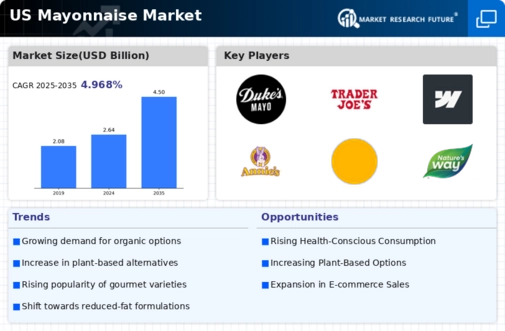Rising Interest in Home Cooking
The resurgence of home cooking is influencing the mayonnaise market, as consumers experiment with recipes and seek quality ingredients. This trend has led to an increase in mayonnaise sales, as it is a staple ingredient in many homemade dishes, from salads to sauces. In 2025, the home cooking segment is projected to grow by 15%, indicating a shift in consumer behavior towards preparing meals at home. The mayonnaise market may capitalize on this trend by promoting its products as essential components for culinary creativity, thereby enhancing brand loyalty and driving sales.
Growth of the Food Service Sector
The food service sector in the US is expanding, which positively impacts the mayonnaise market. Restaurants, cafes, and catering services increasingly incorporate mayonnaise into their offerings, enhancing flavor profiles and customer satisfaction. In 2025, the food service industry is expected to reach a valuation of $900 billion, with mayonnaise being a staple condiment in many establishments. This growth suggests a robust demand for mayonnaise products, as food service operators seek to provide diverse and appealing menu options. The mayonnaise market stands to gain from this trend, as partnerships with food service providers can lead to increased sales and brand visibility.
Increased Focus on Flavor Diversity
Flavor innovation is becoming a critical driver in the mayonnaise market, as consumers seek unique and diverse taste experiences. Traditional mayonnaise is being complemented by a variety of flavors, including spicy, herb-infused, and gourmet options. This trend is evident in the growing popularity of specialty mayonnaise products, which are expected to capture a larger market share in 2025. The mayonnaise market is likely to benefit from this demand for flavor diversity, as brands that offer innovative and exciting flavors can attract a wider consumer base and differentiate themselves in a competitive landscape.
Rising Demand for Convenience Foods
The mayonnaise market in the US is experiencing a notable surge in demand for convenience foods. As consumers increasingly seek quick meal solutions, mayonnaise serves as a versatile ingredient in various ready-to-eat products. This trend is reflected in the growing sales of pre-packaged sandwiches and salads, where mayonnaise is a key component. In 2025, the convenience food sector is projected to account for approximately 30% of the total food market, indicating a significant opportunity for mayonnaise manufacturers. The mayonnaise market is likely to benefit from this shift, as consumers prioritize ease of preparation without compromising on taste.
Emergence of Plant-Based Alternatives
The rise of plant-based diets is influencing the mayonnaise market, as consumers seek healthier and more sustainable options. Plant-based mayonnaise alternatives are gaining traction, appealing to health-conscious individuals and those with dietary restrictions. In 2025, the plant-based food market is projected to grow by 20%, indicating a shift in consumer preferences. This trend presents an opportunity for traditional mayonnaise brands to innovate and expand their product lines. The mayonnaise market may need to adapt to these changing consumer demands by introducing plant-based variants, thereby capturing a broader audience and enhancing market share.






















Leave a Comment